- Home
- Haunted Castles
- Haunted Castles in Wales
Ghostly Castles in wales
Wales offers a wonderful and eclectic variety of ghosts, phantoms, legends and myths and there isn't a single castle in Wales which doesn't have a ghost story or two. Wales is often called the 'Land of Castles' and it is home to some of the most impressive and imposing fortresses in Britain. King Edward I had a hand in creating no fewer than 17castles in Wales as he tried to treat the Welsh princess as insurgents. These castles were intended to scare the native Welsh into submission and show them who their true ruler was.
The Welsh princess also built castles of their own to defend their land from invasion and to protect important routeways. Their earliest castles were built of earth and timber and in the 13th century the Welsh princes began to build their casltes in stone. After the conquest of Wales by Edward I the military need for castles diminished and when Wales and England became one country after the Acts of Union, in around 1536, castles were not needed much for defence any more.
However, when the Civil War broke out between the King and Parliament in 1642, a number of Welsh castles were refortified and became bases for troops supporting King Charles I. From the end of the 18th century some wealthy people redesigned their houses to look like castles or they even built new ones. Castell Coch near Cardiff is such an example.
When you visit these castles in Wales, be prepared to be transported back to some of the bloodiest moments of British history. Imagine the land being ruled by warring lords, when civil war and religious persecution led to massacres and execution and innocent women were burnt at the stake. Face the chill of an encounter with the paranormal and immerse yourself in the sinister tales that enshroud so many castles.
Many of these castles are as impressive today as in the past and the ghosts that roam amongst them have witnessed centuries of unrest and violent times.
CAREW CASTLE
This Norman Castle stands on the low banks of the river Carew, near Pembroke in the south-west of Wales, overlooking a vast Millpond. Gerald of Windsor began the structure as a motte and bailey castle in the 12th century and stone walls and towers were added later on in the same century. He married Nest, a legendary Welsh beauty, and had a turbulent relationship with her. A local Welshman named Owain ap Cadwgan fell in love with Nest. In
1109 he captured her and she was held prisoner at Cilgerran Castle for six years. Eventually Gerald rescued Nest and killed Owain in battle.
A lot of what we recognise as the castle was added by Sir Nicholas Carew in the 13th century. He built the Great Hall, Inner Ward, Middle Ward and Outer Ward. In the 1480s Sir Rhys ap Thomas was the owner of the castle and he added some modern touches to the fortress. He also organised grand jousting tournaments and his emblem was the raven. In the 16th century Sir John Perot added the Elizabethan Mansion which turned the castle into a luxurious mansion.
Carew Castle was severely damaged during the English Civil War and was abandoned in around 1686 when it slowly fell into natural decline. Today the Castle is managed by the Pembrokeshire Coast National Park who also run the nearby tide mill.
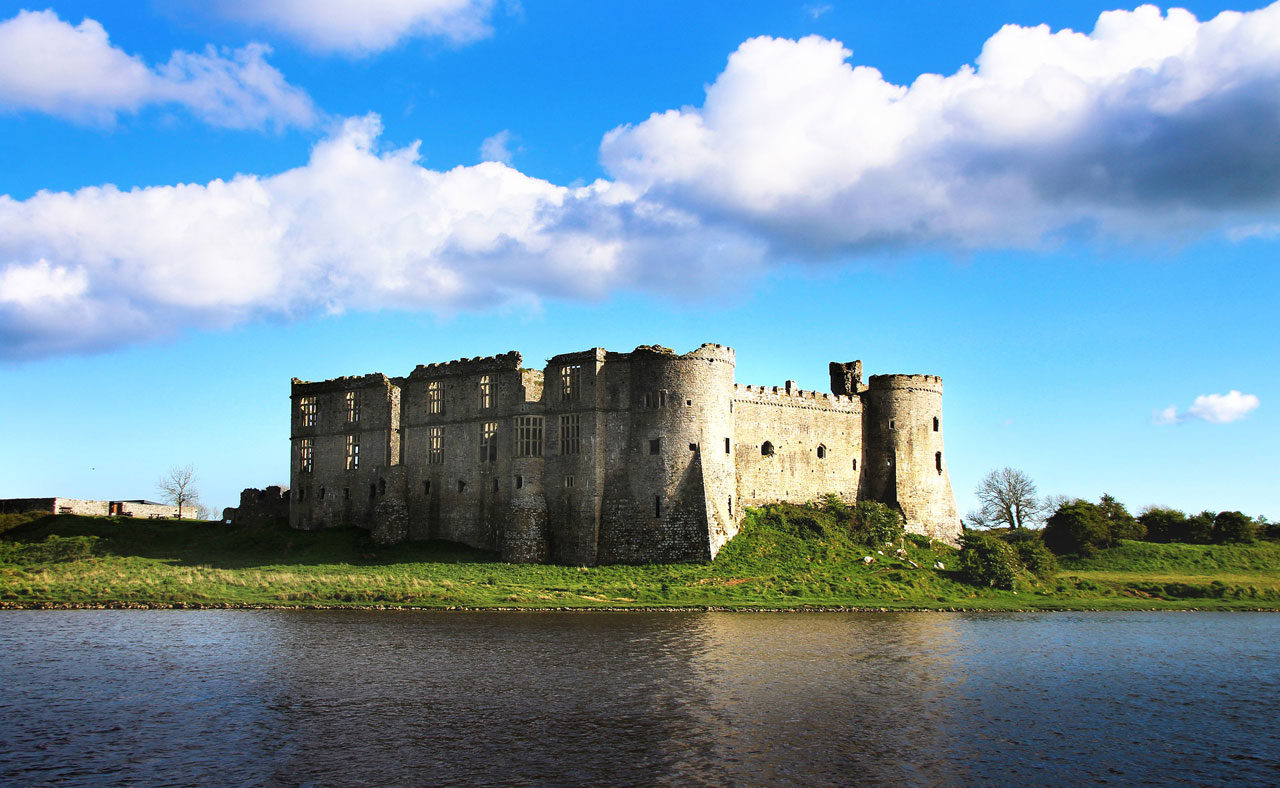
Several ghosts haunt Carew Castle. Clanking sounds of pots and pans can be heard coming from the kitchen, a Celtic warrior is said to haunt the undercroft and the castle is home to a large population of bats and a few ghostly spirits.
One of the ghosts is a white lady who is seen drifting from room to room, walking the ruins in daylight or in the flood of the full moon at night. She is believed to be the spirit of Princess Nest, believed to be the most beautiful woman in Wales. She had many children with three different man and some believe that Carew Castle was her one and only true home.
A a more gruesome story is that of the ghost of the Barbary ape. A tenant of the castle in the 17th century, Sir Rowland Rees, was well travelled. On one of his visits to the Barbary Coast he brought back an injured ape. He trained the ape to respond to his every wish.
Sir Rowland had one son who ran off with the daughter of a local merchant. The girls father by the name of Horowitz turned up one day and had a ferocious argument with Sir Rowland or so the story goes. Sir Rowland ordered the ape to kill Horowitz but the merchant managed to escape with bad injuries. He cursed Sir Rowland with an evil fate. The next day servants found their dead master lying in a pool of blood and the ape dead beside him.
The ghost of the ape now returns to the castle on dark, stormy nights, climbing the stairwell towards the battlements of the Tower, where it releases a horrified howl.
Location: Carew, Tenby SA70 8SL
Official Website: Carew Castle
CASTELL COCH
Castell Coch overlooks the Taff Gorge in stunning Fforest Fawr in Tongwynlais, Cardiff. The Castle only goes back to Victorian times when it was built by the 3rd Marquess of Bute on the foundations of a 13th century fortress. In 1875 he commissioned the architect William Burges to build a Fairytale castle and Burges didn't hold back. The transformation was amazing as William Burges carried out a full reconstruction of the castle. By 1879 the majority of the external work had been completed and the result was the fantasy like Gothic structure that we see today.
Unfortunately Burges passed away in 1881 after catching a chill during a visit to the castle and his brother in law, Richard Pullan, took over. After its completion in 1891 the castle was not used much by the family and in 1950 the 5th Marquess of Bute placed the castle in the care of the Ministry of Works.
Today the site is looked after by Cadw, the Welsh Government's historic environment service. Castell Coch is a popular wedding venue and several movies were filmed there.
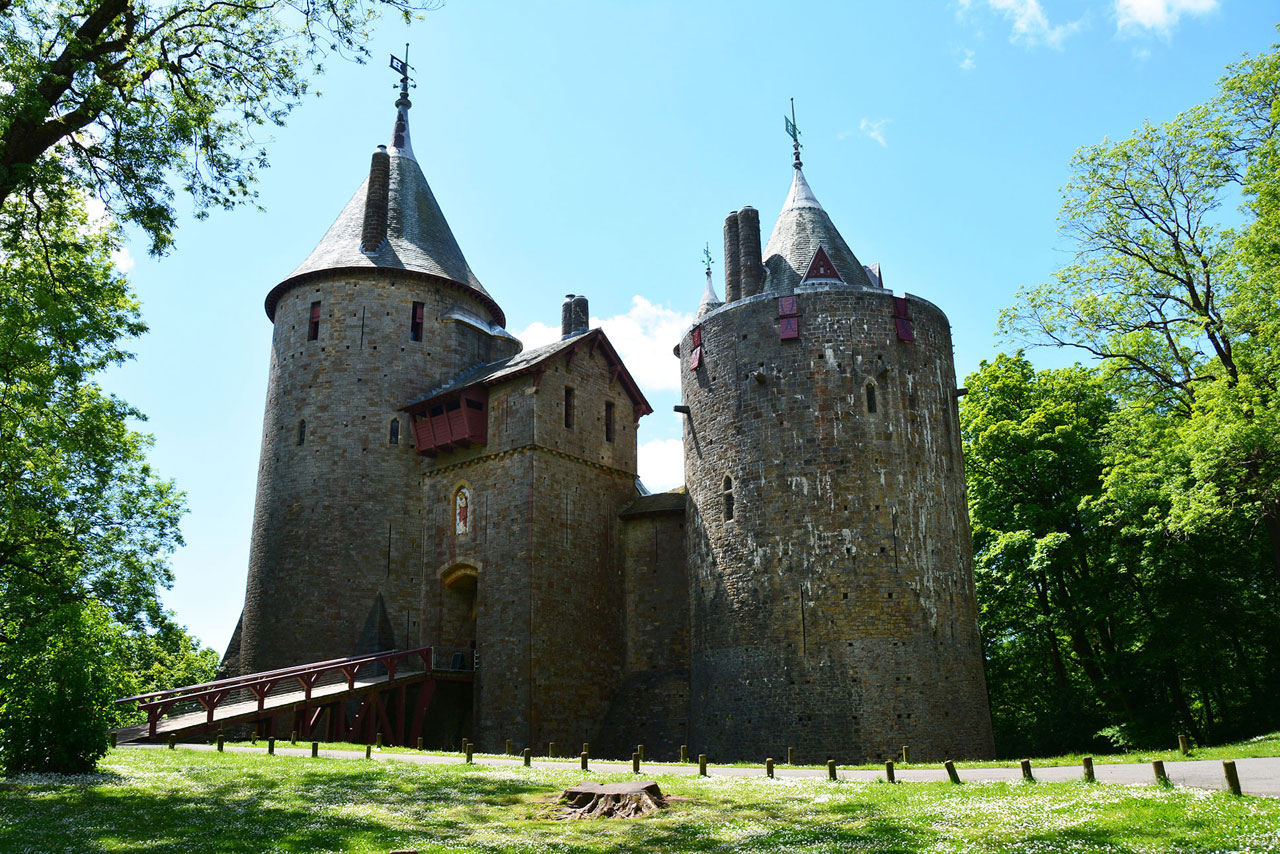
Castell Coch resides on the foundation of a 13th century medieval castle constructed as a hunting lodge for Gilbert de Clare and it is the home of a persistent ghost from the medieval period, the White Lady of Castell Coch. It is said that her young son had fallen into a bottomless pool of water somewhere within the castle and just disappeared. His distressed mother never recovered from the tragedy and died brokenhearted.
The identity of the White Lady has been lost in time but she is believed to have been a resident of the castle with her little boy. After the tragedy she has been wandering the halls and grounds even back when the castle sat in ruins. There is a local rumour that Lady Bute was so bothered by the persistent appearances of the ghost that, when her husband died, she promptly moved out of the castle.
There is also the ghost of a Cavalier who hid treasure somewhere in the castle during the Civil War. The treasure has never been found and his ghost regularly returns to Castell Coch to make sure it is still there and safely hidden away.
Location: Cardiff, CF15 7JS
Official Website: Castell Coch
POWIS CASTLE
Powis Castle, located near Welshpool in Powys, Wales, is as famous for its gardens as for its architecture. The gardens were laid out by Capability Brown in the 18th century and contain a fantastic variety of trees and shrubs, terraces, lawns, statues and topiary. The castle itself dates back to the mid 13th century when Gruffydd ap Gwenwynwyn and his son, Owain, altered and extended an older stone fortress. The fortress was given to them by Edward I in return for their support in his wars against the rebel Welsh princes.
Apart from long drawn out disputes over ownership, nothing much occurred at Powis Castle until 1587, when the castle was sold to Sir Edward Herbert, a son of the Earl of Pembroke. He began many alterations to bring the castle up to the standard of luxury expected in those Elizabethan years. His son William Herbert was created Baron Powis in 1629. William fortified and garrisoned the castle for the Royalists when the Civil War broke out in 1642. The castle was attacked in 1644 and badly damaged. Luckily Cromwell spared Powis Castle the fate of slighting.
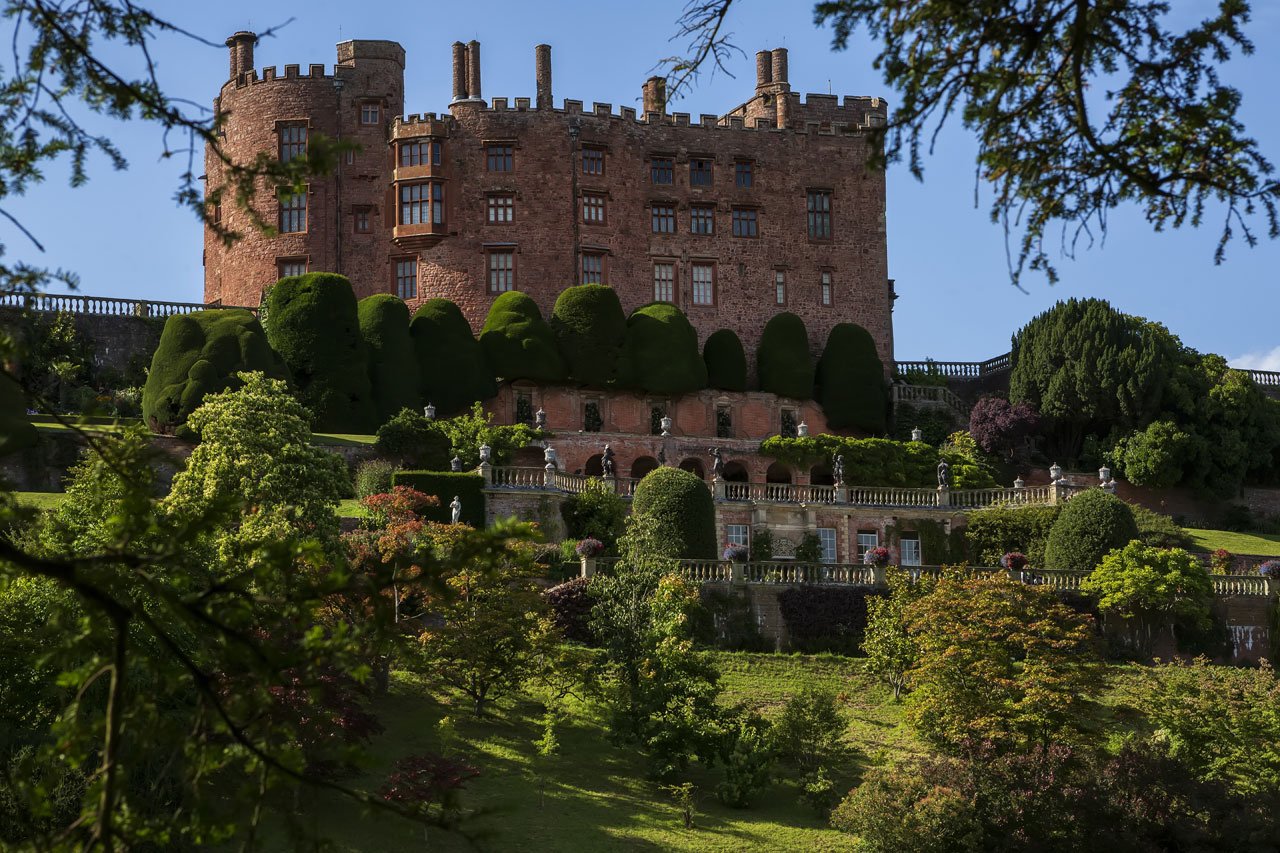
The 3rd Baron Powis repaired the war damage and carried out the construction of a magnificent staircase and the state bedroom. He commissioned William Winde to start building the extraordinary garden terraces which were completed by Capability Brown in the following century. Powys had to flee to France before the restoration was complete.
The castle passed to the Earl of Rochford, then back to the Powis family in 1714 and it finally ended up with Henrietta Herbert in 1801. She married Edward, the son of Clive of India and he took the title Earl of Powis a year later. Powis Castle was given to the National Trust by the 4th Earl in 1952.
With its red sandstone, the evidence of five centuries of occupation, its striking and luxurious interiors, the amazing formal gardens and the relics of India, Powis Castle is a fascinating place to visit. There have also been many reports of ghosts at Powis and it is not unusual for a castle of this magnificence to have aquired a few spectres over the centuries.
The most well known is that of an elderly woman, who arrived at the castle in about 1780 and looked for work. She hoped to earn a little money spinning hemp for the household. As the Earl and his family were away in London the castle steward was prepared to give the old lady employment and put her up in a room that he knew was haunted. A man in a gold-laced suit entered the room, walked to the window to gaze out and left again. A little later he opened the door again and came in. On his third visit that evening the old woman finally mustered up the courage to ask him what he wanted.
She followed the ghost into a small room where he lifted a floorboard. A small chest was inside and the ghost showed her where the key was hidden in a crevice of a wall. Then he instructed the woman that the chest must be sent to the Earl in London and he would stop haunting the castle. The chest and key were sent to the Earl who was so delighted that he arranged for the old woman to be looked after for the rest of her life. Nobody knows what the chest may have contained.
Another ghostly figure that is seen in Powis Castle is The Woman in Black. She seems to be appearing at the castle's fireplaces and is somewhat aloof without really doing much else.
In the grand ballroom the piano is heard playing but as soon as you go inside the room is quiet. The ghost obviously does not like the intrusion and stops playing.
Location: Welshpool SY21 8RF
Official Website: Powis Castle
RAGLAN CASTLE
Raglan Castle, a mighty Monmouthshire fortress, is one of the last true medieval castles to be built in Wales and marks the end of the Middle Ages. Even today, the ruined castle evokes some of the magnificence and grandeur of its heydays back in the 16th century.
Building started in the 1430's by Sir William ap Thomas, the Blue Knight of Gwent, on the site of an earlier Norman motte castle. Sir William oversaw the construction of the Great Tower, a moated tower keep contained within the castle walls. The impressive Tower became known as the Yellow Tower of Gwent.
After his death in 1445 the castle passed to his son William Herbert who supported the House of York and was very loyal towards Kind Edward IV. This loyalty earned William the title Earl of Pembroke. Raglan Castle is where Henry Tudor, the future King Henry VII, was sent to be safely brought up by Sir William Herbert, by then probably the most powerful Welshman at the time. Sir William added luxurious domestic suites of rooms, built a huge gatehouse and added the Pitched Stone Court. Sadly he was executed in 1469.
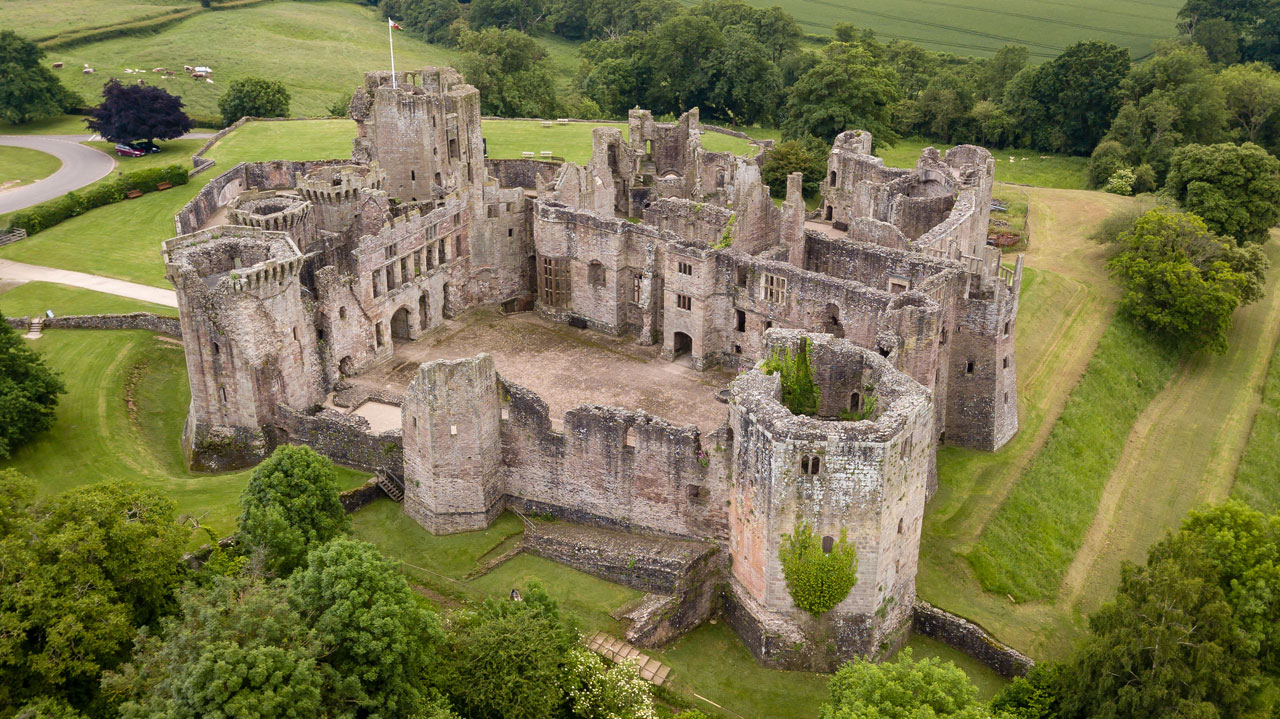
Raglan passed to the Somerset family, Earls of Worcester. In 1589 the 3rd Earl, William Somerset, started to rebuild the hall, extended the Pitched Stone Court and added a fashionable long gallery. Somerset also built a garden with a water parterre and a walled garden, with statues of Roman emperors dotted around the moat walk.
It all changed during the Civil War in 1646 when Parliamentary troops led by Sir Thomas Fairfax besieged Raglan. Henry Somerset, the 5th Earl, realised that he could not defend the castle and surrendered to Fairfax. The castle was built so strongly that Parliament's attempts to destroy Raglan were only partially successful. Today, it is maintained by CADW ( Welsh Historic Monument ) on behalf of the Sectretary of State for Wales.
Raglan Castle is home to a resident from the English Civil War. He is thought to be the ghost of the castle's librarian who tried to hide precious books and manuscripts in a secret tunnel beneath the castle during the siege at the end of the Civil War. His fears were well founded. The result of the Civil War was the deliberate destruction of the castle and hundreds of precious paintings, antiques and manuscripts went up in flames. Visitors have reported fleeting glimpses of a figure gesturing to them from the wing over which the library once stood.
When you walk through Raglan Castle's gloomy and dark passageways you immediately feel a mysterious spine-tingling strangeness hanging over the castle. The mystifying atmosphere of the place with its twisting stairwells and huge, hollow windows is irresistable and makes you want to visit again and again.
Location: Raglan NP15 2BT, Monmouthshire
Official Website: Raglan Castle
RHUDDLAN CASTLE
The position of Rhuddlan Castle at the lowest possible point on the river Clwyd gave the castle a strategic importance in the struggles of Wales against England. Fortification of some sort can be traced all the way back to the 8th Century and a motte and bailey style timber castle existed to the south, built by Robert of Rhuddlan in 1073.
In 1277 Edward I began constructing Rhuddlan Castle and he employed Master Architect James of St George to design one of the first concentric, or 'walls within walls' castles. In around 1281 royal apartments were added followed by lead roofs onto the stone-based towers and shingles on the King's Hall. So that the castle could be supplied from the sea a dyke was built and the river Clwyd was diverted. Men were brought in from all over England to dig the ditch and moat and a type of swing-bridge was constructed so that ships of up to 40 tons could sail right up to the castle.
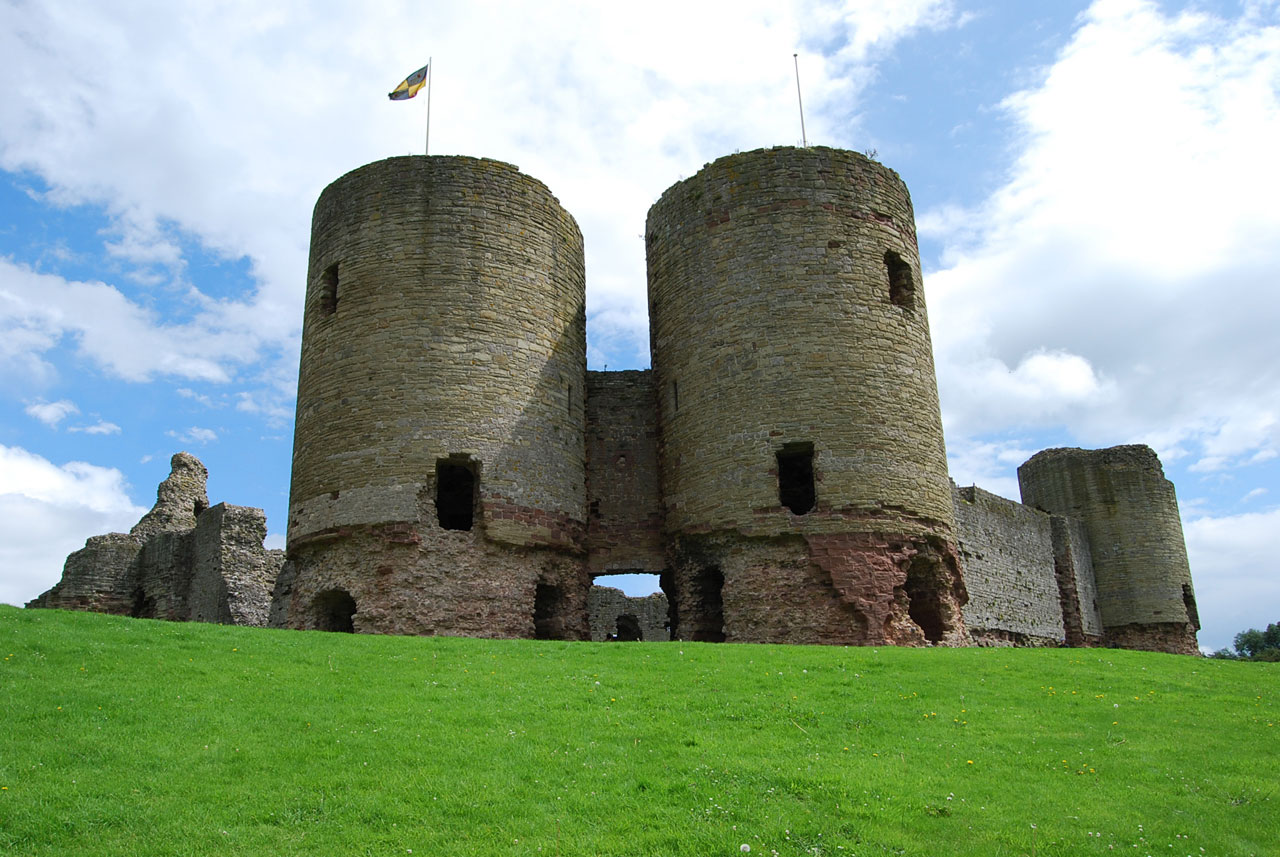
Edward used the castle as a base for his wars in 1277 and 1282. In 1284 he promised to present the Welsh people with a 'Prince born in Wales, who could speak no English and whose life and conversation nobody could stain'. His son Edward, later Edward II, who was born at Caernarvon, was the first Prince of Wales but history has never quite determined where the ceremony took place.
Rhuddlan Castle was severly damaged and slighted during the Civil War after Colonel Mytton had captured the castle for Parliament.The Royalist stronghold was wrecked by order of Parliament in May 1648 and thereafter it continued to decay steadiy, especially when it was used as a ready-made quarry. Restoration began in 1944 when the Government took charge and today Rhuddlan Castle is managed by Cadw, the Welsh Government's historic environment service.
Rhuddlan is said to have its own ghost as have so many castles up and down the country. This is the tale of Erilda, the beautiful daughter of the King of North Wales. She was supposed to marry Morvern, Prince of South Wales, and the union was supposed to bring peace between the two nations. She tried everything to escape her fate but failed. On her wedding day, just before vows were to be exchanged, she was rescued by a mysterious knight with a red plume in his helm.
The knight murdered the groom and her father and then carried her off. But he revealed himself as a demon and Erilda was never seen alive again. The sobbing spirit of Erilda has been seen running through the inner ward, unable to find peace and unable to leave the place of her tragedy.
There are also accounts of the sound of footsteps of marching soldiers on the site and with all its history there is certainly an atmosphere of eeriness at Rhuddlan which you cannot escape.
Location: Castle St, Rhuddlan LL18 5AD
Official Website: Rhuddlan Castle

